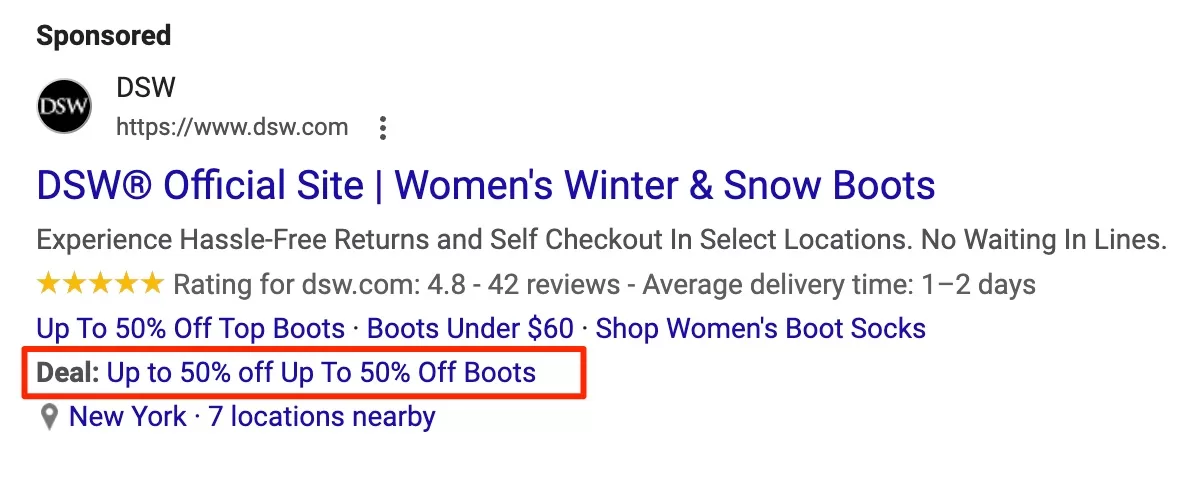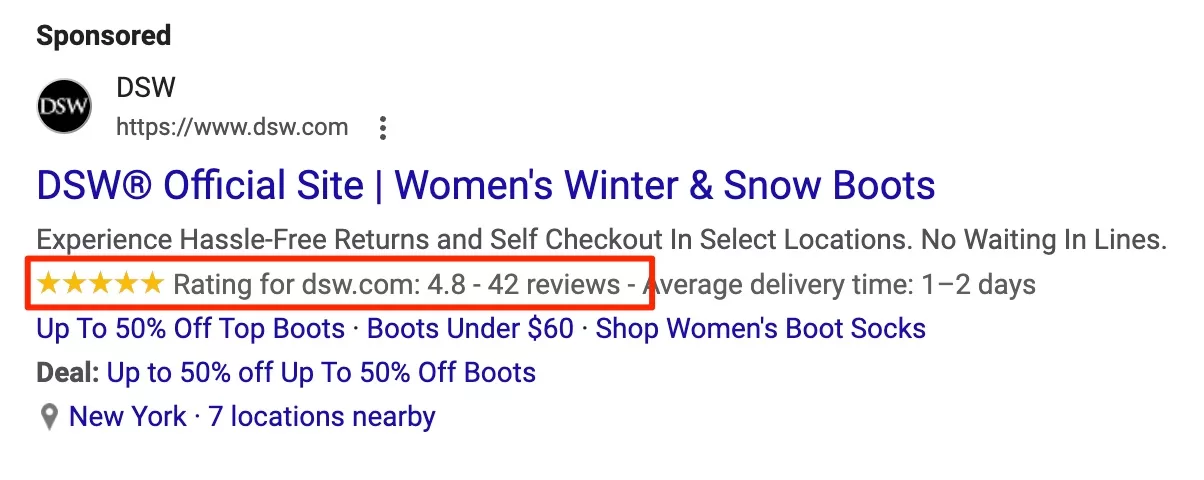
When you run Google Search Ads, there are a lot of things happening in the account. You have your keywords, targeting, audiences, devices, bids, etc. But the only part that is visible to a user is just your ad.
And if that is not enough, that ad is not that big. I mean, you have 3 headlines and two descriptions. Both are limited in length. And this small piece of an ad has to convince users to click on it and hopefully engage with your website enough to buy something from you.
That’s a big task for just a few lines of text, wouldn’t you agree?
Learning how to write a great ad takes time, as with anything else. You can speed this process up by learning from others, and I assume that’s one of the reasons you’re reading this post.
One key thing you have to understand about ads is that clicks are made by people. It sounds weird to say it, but often advertisers forget that behind each click, there is a person who made a decision to click on the ad based on specific circumstances. And their decision was conscious. Or was it?
Let’s look at what makes us, humans, tick. Or click. When writing ads I always keep that in mind and I will share some of psychological tricks, that might help you increase clicks on your ads.
SIDENOTE. Everything you read needs to be tested. There is no silver bullet for all types of businesses.
Bandwagon Effect
One of the most popular ones and can be observed even in everyday life. The “bandwagon effect” is a psychological phenomenon in which people tend to adopt certain behaviors, beliefs, or opinions because many others are doing the same. Simply put, “I do this because everyone is doing it”.
Next time you’re waiting for a green light to cross the street try to spot if someone is crossing it on the red light. If only a few people do it, the rest will probably wait. But if enough people start crossing on the red light, you will notice that more people join in. Experiment right in front of your eyes.
There are several factors at play here.
Social Pressure
People don’t like/want to be left out. For this reason, they might do what many people are doing even though they do not agree with it and might otherwise not do it.
Perceived Popularity
Today, with TikTok trends and YouTube, it’s easy to spot this one. If there is a trend, others might accept it as a “correct” behaviour or just a “popular” choice.
Cognitive Ease
Our brain is lazy. It always wants shortcuts; it does not want to burden you with thinking and making choices. So, if there is an easier way than analyzing all the information, it will most likely be chosen.
“OK, Rokas. This is great. How can I use it in the ads?” I’m glad you asked.
Here’s an ad from L.L. Bean shop. It’s an OK ad, but can be spiced up with phrases like “Loved by men around the world”, or “Popular choice in US”.

Sometimes even one phrase can make a difference. Your ads are shown along with other ads and organic results. People are overwhelmed with choices. And when I say people, I mean brains. Help them make a decision by implying that your product is used, liked, and purchased by many others.
Scarcity
Another classic. The “scarcity effect” is the psychological principle that items, opportunities, or experiences that are perceived as scarce or limited are often seen as more valuable or desirable. When something is in short supply or is perceived to be in high demand with limited availability, people tend to assign a higher value to it and are more motivated to acquire it.
Can you remember one very big company using it to sell iPhones? Ups. Yeah, Apple loved to use scarcity by saying that they couldn’t make enough phones, so people stood in line and waited for them. They also got news coverage about it. Does it sound weird that such a company as Apple could not predict sales several years in a row?
Scarcity is probably one of the most used marketing tactics, and you should use it for search ads as well.

In this ad, a promo extension is used to communicate the deal. It does not say directly that something is limited, but the sale itself implies that. All sales have to come to an end. But DSW.com could have used a countdown timer as well to show how many days are left until the sale ends.
When you edit your ad, type in “{” and you will see a drop-down. Select Countdown and enter the end date:

You will see it in your ad like this:

Obviously, you don’t have to use a countdown. You can just specify in the ad that your product is limited in quantity or time: “Limited edition,” “Only 34 left,” etc.
Social Proof
Very similar to the Bandwagon effect, this principle suggests that people look to the actions and behaviors of others to determine the appropriate course of action. If people are unsure about a decision or action, they would look at what others are doing.
The idea behind social proof is that if many people are doing something or believe in something, it must be correct or beneficial.
I don’t think I will surprise anyone with social proof as it is used almost everywhere in marketing. Just don’t forget to use it in the ads as well, like DSW did.

Or how Policygenius did it in this ad. I presume it was using a quote from a customer. It can even be fake. There is no way to tell. But it can affect your clicks.
Commitment and Consistency
Moving on to a lesser-known commitment and consistency principle, this principle is a psychological concept that describes a person’s innate desire to be consistent with their past actions, statements, or decisions. It is believed that once a person makes a commitment, especially if it’s a public one, they are more likely to follow through.
That’s why if you make a New Year’s resolution to go to the gym in front of many of your friends, you are more likely to do it.
What we’re looking for here is one of the underlying points – initial commitment. Once a person makes a small step or action, they are more likely to continue in that direction. Can you name one very popular tactic that uses this principle? Lead magnets. A business asks for your initial commitment – enter your email and download a free something. Then, you will receive several emails or calls with some offers, and people will be more interested in those offers.
Look at several ads for a search “email software”:

The first ad, using site links, offers a free 14-day trial. This is also part of the initial commitment. The second ad, for Mailchimp, could use that principle by offering a free signup. I mean, they have a free plan.
Think of a small action a user can take on your website and communicate it in the ad.
Loss Aversion
Getting to more interesting things. The “loss aversion” comes from behavioral economics and cognitive psychology, which describes the human tendency to prefer avoiding losses over acquiring equivalent gains.
Simply, losing something is a bigger displeasure than gaining something of equal value. Let’s look at the example. If I told you that there is a 50:50 chance of you winning $100 in a coin toss or losing $100. You are less likely to agree. But if I say that you can lose 50$, but you can win $100. You are more likely to agree.
Basically the gains have to be a lot bigger to outweigh the displeasure of a loss. When people buy something they spend money, they “lose it”. Counteract that feeling with “Money back guarantee” or in Kenetrek instance – 90+ days return policy.

Emotional Appeal
We’re human, and being emotional is what we do. The “emotional appeal” principle refers to the use of emotions in persuasive communication.
Use emotions, rather than logical arguments, to persuade or influence an audience. Emotions register better with our brains. Change your ad texts to reflect that. Look at what Vivaia.com did here:

Instead of describing the features of the product, they appealed to emotions of how it feels walking in their shoes.
The “bizarreness effect.”
Have you noticed that something that stands out draws your attention? This phenomenon where bizarre, unusual, or atypical information is better remembered than ordinary information is called the “bizarreness effect.”
It is based on the idea that strange or odd events or details stand out more in our memories because they deviate from the norm and are, therefore, more memorable.
Look at this first ad. Regular ad for flights to NY.

But what if you add text that is a bit different from the rest of the ads? Adding “wow” might be something that other sellers won’t do. It is also something you would not expect to see, so it might increase clicks.

You can play around with different texts. For example, use this text from the Superman movie (I think).

But I do have to warn you not to take it too far. If you work for a company, make sure legal or other department signs off. If you’re small business, you can be more edgy.
The “rhyme-as-reason” effect
Also known as the “Eaton-Rosen phenomenon,” it is a cognitive bias where statements that rhyme are often perceived as more truthful or persuasive than those that don’t.
Funny that, right?
The idea is that the rhyming makes the statement more memorable, fluid, and aesthetically pleasing, leading individuals to unconsciously attribute higher accuracy or credibility to it.
Remember this one: “An apple a day keeps the doctor away.” It kinda seems like its 100% true. But actually eating or diets are a bit more complicated.
I don’t have to tell you that it’s easier said than done. Can we make this ad from Timberland rhyme?

How about this:

Yes, lame, I know. But can it work? Maybe. Should you test it? Of course. This could involve two effects: rhyme-as-reason and bizarreness effect.
You can also ask ChatGPT for help. I took this text from the ad and asked it to create a rhyme:
“Shop boots and shoes, take a stroll,
Timberland’s for the bold.
Experience comfort, old to new,
Latest apparel, waiting for you.”
You have to admit it’s pretty good.
Conclusion
I have to admit that I haven’t used the rhyme-as-reason effect in the ad. Mostly due to clients. But I will try it on my book ads. See how that goes.
The rest of the principles have been tested, and I can assure you that they work. Will it work for you? I’m not sure. As I said at the start, test all of them. You don’t know how many times small changes in ads affect CTR (click-through rate) and increase clicks, especially if you don’t change your ads often. People might develop ad blindness, which means they don’t see your ads as they are used to. Stir things up.
Also, you won’t be able to apply all of the effects since businesses are very different and they have different audiences. Also, be careful when writing something that might offend people or hurt the business. As I mentioned, with smaller companies, you have a lot more freedom in testing whatever you want. With established brands, not so much. There are brand directions, tone of voice, legal, and other intricacies that will not allow the usage of some texts.
I share weekly tips on how to create, manage, and scale Google Ads campaigns. Subscribe to my free newsletter.
I’m also down with connecting on LinkedIn.
Or follow me on X, for some quick updates and fast insights.
